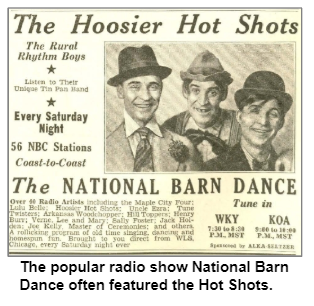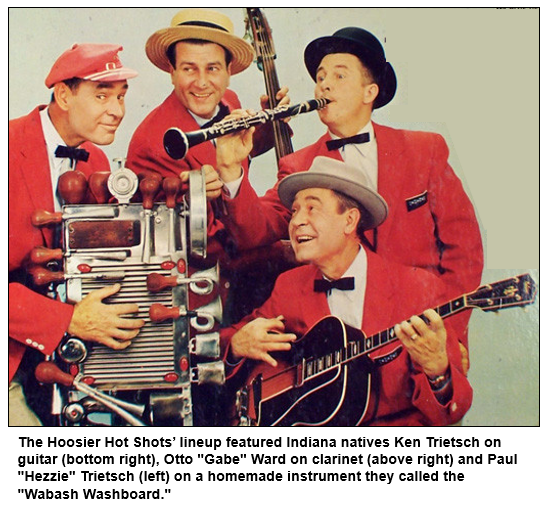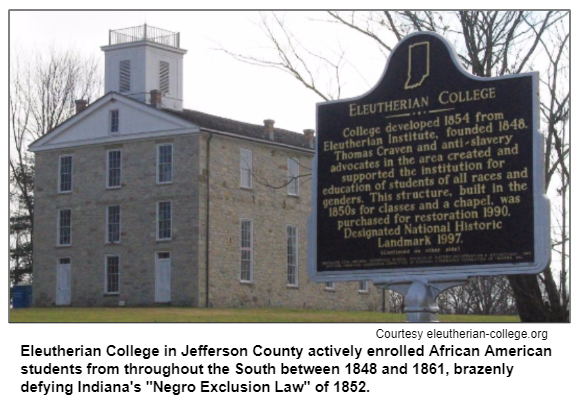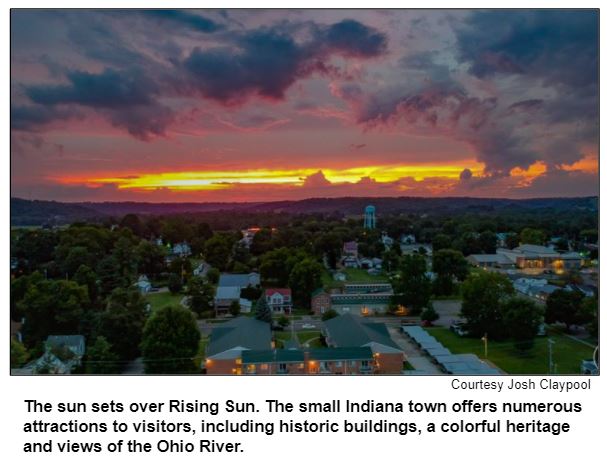
Saturdays, noon to 1 p.m. ET on WICR 88.7 FM.
Or stream audio live from anywhere on WICR Online!
You can listen to recent shows by clicking the podcast links below, or check out our extensive archive of past shows available as podcasts.
November 28, 2020
Have you heard of The Hoosier Hot Shots? encore
With percussion instruments that included a makeshift washboard and a stage routine punctuated by comic banter between their musical numbers, they were nationally known entertainers from the 1920s through the mid-1940s.

The three primary members of the Hot Shots band were Otto "Gabe" Ward, who was born in Knightstown and grew up in Elwood, and two brothers, Ken and Paul "Hezzie" Trietsch, who hailed from the small town of Arcadia in Hamilton County. The Indiana State Museum periodically has exhibited Gabe Ward's clarinet and Hezzie's unusual washboard instrument, which he made by hand; the exhibits also have included vintage posters for some of their 21 movies.

In an article about the Hoosier Hot Shots in the Fall 2018 issue of Traces, the Indiana Historical Society's magazine, Todd wrote:
"During two of the most tumultuous times in our nation's history, the Great Depression and World War II, Americans found comfort in the silly songs and crazy antics of a band from the flatlands of central Indiana ... Their sound and lyrics were unlike anything Americans in the early 20th century had ever heard before."
A sample lyric from a Hot Shots song:
From the Indies to the Andes in his undies
And he never took a shave except on Mondays
He didn't eat a thing but chocolate sundaes
'Twas a very, very daring thing to do.

Periodically during our show, we feature brief excerpts of the Hoosier Hot Shots' recordings to give listeners a flavor of their distinctive routines.
Their signature line was a question - "Are you ready, Hezzie?" - posed by Ken Trietsch to his jokester brother just as the Hot Shots were about to kick off a routine.
Ken (1903-1987) and Hezzie (1905-1980) Trietsch came from a musical family in Hamilton County of five sons, all of whom played multiple instruments.

Major success followed on National Barn Dance, which also launched the careers of Gene Autry, Patti Page and other entertainers. By the mid-1930s, the Hoosier Hot Shots had added a fourth member, Illinois native Frank Kettering, who played the bass fiddle, organ, piccolo and other instruments.
Among the quartet's most popular songs was Whistlin' Joe from Kokomo. According to Todd's article, the song was one of several Hot Shots' tunes featuring the names of Indiana towns.
During World War II, the Hoosier Hot Shots joined USO tours of North Africa and Italy. (Kettering, though, was drafted. He was replaced by a series of musicians who also weren't from Indiana.) The band's popularity waned by the early 1960s.
Click on the links below to listen to samples of songs from the Hoosier Hot Shots catalogue:
- The Coat and the Pants do All the Work (But the Vest Gets All the Gravy)
- I Like Bananas (Because They Have No Bones)
- From the Indies to the Andes in his Undies
Roadtrip: Eleutherian College in Jefferson County
Guest Roadtripper Mark Furnish invites listeners to join him on a journey to learn about the short but significant life of Eleutherian College, one of only three institutions in antebellum Indiana to provide education regardless of race or gender.
Located in Lancaster Township of Jefferson County, only ten miles north of the Ohio River and the slave state of Kentucky, the school actively enrolled black students from throughout the South between 1848 and 1861, brazenly defying Indiana's "Negro Exclusion Law" of 1852, which prohibited the migration of free African Americans into the state.
As Mark explains, "The school was the product of a community of white abolitionists, largely but not exclusively New England in origin and Baptist in faith, who battled slavery for roughly thirty years by means legal and illegal, including working closely with free blacks and whites throughout the region as part of the Underground Railroad." Mark wrote a dissertation on Eleutherian College while completing a PhD at Purdue University
The nonprofit organization Historic Eleutherian College Inc. was established in 1994 to restore the original building and educate the public about its historical significance. Those interested in witnessing first-hand this important site of African-American history in Indiana can do so by contacting the organization and making an appointment to see it in person.
Check the websites linked above for current information on hours and possible Covid-related closures.
History Mystery
Not only did two of The Hoosier Hot Shots grow up in Hamilton County, so did the breeder who initially owned and trained Trigger, the horse who became famous in Hollywood. Hamilton County historian David Heighway was among our guests when Hoosier History Live explored the Indiana roots of Trigger's owner, Noblesville native Roy Fletcher Cloud.
Although Trigger is eternally associated with Roy Rogers, the celebrity stallion initially appeared in a classic move in 1938 that didn't star the cowboy actor. The movie wasn't a Western; in fact, it wasn't even set in the United States. And Trigger was known then by his original name, Golden Cloud.
Question: What was the classic movie in which the stallion made his debut before becoming Roy Rogers' faithful steed?
Hint: In the mystery movie, the horse was ridden by Olivia de Havilland.
As this is an encore show, please do not try to call in for the History Mystery..
Nelson Price, host and historian
Molly Head, producer/general manager, (317) 927-9101
Mick Armbruster, associate producer
Cheryl Lamb, administrative manager
Richard Sullivan, senior tech consultant
Pam Fraizer, graphic designer
Garry Chilluffo, consultant
Please tell our sponsors that you appreciate their support!

 For organizational sponsorship, which includes logos, links, and voiced credits in the show and in podcasts, email molly@hoosierhistorylive.org, or call (317) 927-9101 for information. Our podcast listens are increasing and we are being distributed on Indiana Memory and the National Digital Public Library. Grow with us as our podcast and internet presence expands! Thanks also to Visit Indy, Fraizer Designs, WICR-FM, Henri Pensis, Aaron Duvall, Kielynn Tally, Heather McIntyre, Justin Clark, and many other individuals and organizations.
For organizational sponsorship, which includes logos, links, and voiced credits in the show and in podcasts, email molly@hoosierhistorylive.org, or call (317) 927-9101 for information. Our podcast listens are increasing and we are being distributed on Indiana Memory and the National Digital Public Library. Grow with us as our podcast and internet presence expands! Thanks also to Visit Indy, Fraizer Designs, WICR-FM, Henri Pensis, Aaron Duvall, Kielynn Tally, Heather McIntyre, Justin Clark, and many other individuals and organizations.
Thank you!
We'd like to thank the following recent, new and renewal contributors whose donations help make this show possible!
- Stacia Gorge
- Ann Frick
- Margaret Smith
- Rachel Perry
- Tom and Linda Castaldi
- Serita Borgeas
- Tom Swenson
- Doug Winings
- Theresa and Dave Berghoff
- Dr. Geoffrey Golembiewski
- Jeanne Blake in memory of Lenny Rubenstein
- Chuck and Karen Bragg
- Kathleen Angelone
- Wendy Boyle
- Sharon Butsch Freeland
- Bruce and Julie Buchanan
- Dr. Robert and Jill Clements
December 5, 2020 - coming up
Rising Sun and Indiana's smallest county
Both in population and geographic size, it's the smallest county in Indiana. But it's considered among the most scenic.

One of the few harp factories in the world is housed in a historic building on Main Street in Rising Sun, where Riverfront Park is a popular destination to savor views of the Ohio River.
In the Rising Sun Historic District, the Greek Revival-style Ohio County Courthouse, which was built in 1845, is the oldest county courthouse in continual use in Indiana.
Ohio County historian Cliff Thies, a lifelong resident of Rising Sun, will be Nelson's guest to share insights about his home turf. Cliff is the executive director of the Ohio County Historical Society and the Rising Sun History Museum, which occupies a 20,000 square foot structure that was built in the 19th century as a plow factory.

Ohio County also has a heritage in furniture-making that stretches back to the mid-1800s. Also in the 19th century, renowned silversmith Samuel Best moved from Cincinnati to Rising Sun.
So what's the population in 2020 of our state's smallest county?
According to our guest Cliff Thies, the current estimate is 6,128.
|






